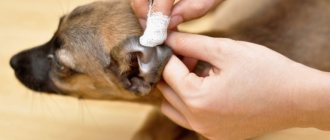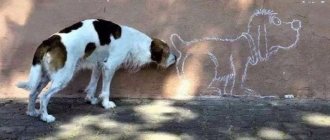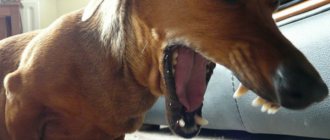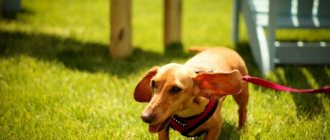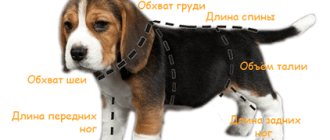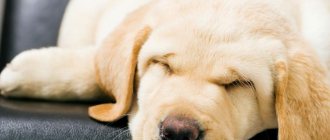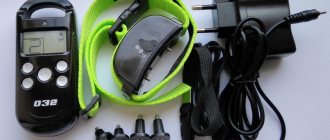When planning to buy your dog a new harness, collar or winter coat, you always need to know the size of your dog. While it may be tempting to select a product size based on your guess, this may result in unnecessary and time-consuming exchanges or returns in the future.
Even within the same breed, not all dogs have the same shape. Many French Bulldogs are stocky and muscular, while other Frenchies are slimmer and petite. Some dachshunds have exceptionally large and strong chests, while others have more slender chests. You may not realize this if you are shopping for dog clothing or accessories such as harnesses and collars for the first time.
Dog clothing retailers use several key dog measurements in their size charts: chest girth, neck girth, back length and height (also known as withers). Not sure what some or all of these mean?
We will tell you how to correctly measure the neck girth, chest girth, back length, height and paws of your dog, let's move on to the main thing - how to measure a dog.
How to measure a dog's neck circumference
When you buy a collar and leash, you need to know the circumference of your dog's neck. Even if it is an adjustable collar, the measured size of your dog's neck should be within the stated neck circumference range. For example, if your dog's neck length is 30 cm, order an adjustable collar from 28 to 40 cm.
To measure the circumference of your dog's neck, take a soft measuring tape or stamped measuring tape and wrap it around your dog's neck. Make sure the measuring tape is between your dog's shoulder blades and the top of his chest. Pull the tape until it fits snugly, but not too tightly. If you don't have a tape measure, you can use a piece of string and then measure it with a ruler. You can also measure your dog's current collar from the end of the buckle to the exact hole that is being used.
© shutterstock
Remember that when your puppy sits or rolls over, his skin and fat deposits are redistributed. A collar that fits when he stands up may be too tight when he lies down. Take several measurements with your dog in a different position to ensure a proper fit.
You don't want the collar to be too tight on your dog's neck, so use the "two-finger rule." Once you fasten your dog's collar, you can easily slide two fingers under it.
Height of dogs of different breeds
Breeds range from decorative pocket dogs to specimens weighing more than 100 kg. Pets are classified according to their character, thickness and color of fur, popularity, and height. They are distinguished by purpose: protector, guide, hunter, cattle dog. The breeder can choose the pet according to his preference.
| Classification by height at withers, weight | Height, cm | Weight, kg | Breeds |
| Very small | 30 | 5 | Rabbit Dachshund, Papillon, Pekingese, Yorkshire Terrier |
| Little ones | 30-40 | 5-10 | Shiba, Japanese Spitz, Miniature Schnauzer |
| Average | 40-56 | 10-20 | Bearded Collie, Shar Pei, Australian Kelpie |
| Large | 56-65 | 20-30 | Airedale Terrier, Boxer, Collie |
| Very big | From 60 | From 50 | Bullmastiff, English Mastiff, Newfoundland, South Russian Shepherd |
The withers are an important part of a dog's body. Located between the shoulder blades below the cervical vertebrae. The height of animals is measured at the height of the withers. The indicator is needed to determine the physical development of the pet, compliance with breed standards, to select clothes and harnesses. According to the height of the scruff, they buy dog carriers and build kennels.
How to measure a dog's chest
When looking to buy a new dog harness or dog jacket, you need to know your dog's chest circumference. Chest girth is the measurement of the largest part of your dog's chest, usually just behind the front legs.
To measure chest girth, first press one end of the measuring tape against your dog's spine. While the dog is standing, wrap the tape behind the dog's front legs and around his body. Don't measure directly under your puppy's armpits unless that's the widest part of the waist. Place the end of the tape measure next to the beginning; where it intersects is your dimension. To achieve an optimal fit, use the "two finger rule" and place your index finger and middle finger between the measuring tape and the dog.
© shutterstock
K How to measure a dog to choose a harness
In this case, it is best to use a tailor's meter, which is used by tailors. With its help, you can measure not only the circumference of the animal’s neck, but also other parts of the body. To purchase the most suitable ammunition, the meter should be applied in such a way that it fits snugly without sagging. A harness for dogs not used as sled dogs requires three measurements:
- from the withers (scruff) to the base of the tail;
- the volume of the sternum at its widest point, just behind the front paws;
- neck volume.
To select a harness for a working sled dog, 2 measurements are required:
- the size of the area from the highest point of the nape to the base of the chest between the front legs;
- length from the base of the sternum to the base of the tail.
When purchasing working equipment, the most accurate measurements are required, since while riding the dog should not experience discomfort, pain or feel that anything is bothering him. A person's palm should be placed between the harness straps and the dog's body. This will help avoid discomfort and constraint while moving. If the harness is too loose or too tight, it will not only be uncomfortable for the dog, but can also cause problems in the spine and lead to spine deformation.
Preference should be given to high-quality products, durable, with strong fittings. If a stud or other part of the harness comes off while the animal is active, it can dig into the dog's skin, causing pain and leaving wounds that are a gateway for pathogens.
How to measure the length of a dog's back
Determine the length of your dog's back (or topline) by placing the beginning of the tape measure on the dog's neck. The base of your dog's neck is where the collar naturally fits. Holding the tape measure with one hand, pull the tape straight through the dog's spine until you reach the base of the tail.
Do you have a male dog? If so, you may need to size down a bit depending on the fit of the garment. If the coat or hoodie you buy is not shaped to avoid dog mess (meaning the bottom of the garment should be shorter than the length of the back of the garment), there is a chance that your dog will pee on it.
© shutterstock
Where is the withers and why do you need to know this?
The dog's withers are the part of the back that is located on the side of the spine at the base of the neck and shoulder blades. The middle of the withers is located just behind the highest point on the shoulder blades. The peculiarity of the withers is that the skin on it easily gathers into a fold and is pulled upward.
To understand exactly where the dog’s withers are, you need to do the following manipulations: with both hands, grab the dog’s front paws at the base and move up until you have a fold of skin in your hands. Take the fold of skin in one hand, squeeze it a little and lower it towards the dog’s body until your hand rests on the shoulder blades. This fold of skin is called the scruff or withers of a dog.
In the process of evolution and development of species, the skin on the withers of mammals has become thicker, rougher and less sensitive. During fights, dogs try to grab each other in the neck area, since this part of the body is the most vulnerable. While on the defensive, the dog exposes its back and withers to the enemy. If the enemy grabs the dog by the withers, it will not be in the most advantageous position, but will not receive serious injuries.
In a fierce fight, the dog, feeling more vulnerable, turns its back or side to the enemy, protecting the soft tissues and throat. It is difficult to say for how long the skin on the dogs’ withers was vulnerable to the bites of opponents. Modern research has shown that this area of the body contains the fewest nerve endings.
A dog participating in mating can get injuries to the withers. A male jumping onto the female’s back holds the body with his front paws and the withers with his teeth. Serious injuries are rare, but if your dog appears restless after mating, carefully inspect his sides and withers for scratches and punctures. If you find injured skin, the hair around the scratches should be cut off, and the wounds themselves should be treated.
Each owner should clearly know where the dog’s withers are, how to collect a skin fold for injection, or properly treat this area in case of inflammation. A clear understanding of the anatomy of a dog will be useful to you in order to correctly carry out parasite prevention or medical procedures related to treatment.
The uniqueness of the structure of a dog's withers is that despite the very small number of nerve endings, puppies have a special reflex. When the mother dog takes the puppy by the fold of skin at the withers, the baby tucks its hind legs and freezes. Over time, in adult dogs, this reflex atrophies as unnecessary. However, the fold of skin at the withers is often used to hold the animal still, for example, while brushing teeth or other manipulations. The choice is quite simple to explain; when you hold a dog by the withers, it may be unpleasant for him, but it definitely won’t hurt.
The height of dogs is usually measured at the withers, that is, the measurement is taken from the ground to the highest point of the back at the shoulder blades.
How to measure a dog's height
When purchasing a dog carrier, you need to know the length and height of your dog's back. For a hard-sided pet carrier, increase your dog's height by 15-20 cm to make it comfortable. For a soft-sided pet carrier, add 5-7cm. Brands often provide appropriate weight ranges for pet carriers as well, but knowing the exact length and height of your dog's back will ensure the best size is selected.
To measure your dog's height, make sure he is standing straight against a wall. His feet should be evenly spaced on the floor. Small dogs are more excitable and getting them to stand still can be a challenge. With the help of another person holding your dog, consider measuring your puppy's height on a table so your dog has nowhere to go.
Start by feeling your dog's withers. This is the highest point of your dog's shoulder blades, where the shoulder blades and neck meet. This is the highest point on your dog's body (not including the head). Run the measuring tape from the floor to the dog's withers. Make sure the tape is straight and perpendicular to avoid measurement errors. In short-haired dogs, such as French bulldogs and corgis, the withers are easier to find.
You can also place the ruler where your dog's shoulders are highest. Make sure one end of the ruler is touching the wall. Then mark its bottom with a pencil. Don't want to write on the wall? Use sticky putty or clear tape. You can also measure your dog in front of the refrigerator and use a magnet to mark the spot.
© shutterstock
Measuring the height of a dog
Any control of the development of puppies, as well as determining the standard of a particular breed, requires certain measurements. First of all, it is a measurement of growth. We will talk further about how to correctly take this measurement.
From the video “Medical procedures and the withers of an animal” you will learn how to properly give injections in this area of the back.
Instructions
Below is a complete list of points, following which, you can correctly determine your height. Height is determined by measuring the distance from the highest point of the animal's body (withers) to the floor. In order for the measurements to be accurate, the pet must be placed on a flat horizontal surface. Most likely, you will need an assistant who will hold the animal in an even position, but without much strain on the muscles and paws.
Small breeds are best measured on a flat table surface, while large animals will be more comfortable on the floor. You can correctly determine the starting point by applying a ruler or book to the withers. A special stadiometer is usually used for measurement. However, if you don’t have it on hand, you can use the following methods.
- Two rulers. One of them should be placed on the pet’s back, the other should measure the distance from the floor to the second ruler. The best way to do this is shown in our photo.
- Children's method. If you are the owner of a large dog, you can measure your pet the same way you measure children. Place the animal against the wall and make a mark where the shoulder blades are located. This method is unlikely to be suitable for small breeds.
Height directly depends on the size of the breed to which the pet belongs. It is important to understand that this parameter may differ from breed standards if your puppy’s parents were representatives of different breed groups. In addition, in mongrels and mixed breeds, it is generally impossible to predict it, since a large amount of blood is mixed there. Therefore, the size of a mature puppy can significantly exceed the size of its parents.
How to measure a dog's paw size
Dog shoes and boots can range from XXX-Small at 3cm at the widest part to XXX-Large at 9cm. Since your dog's paws may be different sizes, you will need to measure each one separately. To get an accurate measurement, trim the toenails.
Place your dog's paw on a piece of paper and press it gently with your fingers. This mimics the way his paw spreads out when he walks. Mark the front and back of his paw, including his toenails, with a pencil. Then measure the distance between the lines.
You can also wet your dog's paw and press it against a piece of paper. As with the pencil marking technique, make sure that he is fully unfolded and that you take into account his paw claws. If your dog hates water, measure the length and width of his paw using a tape measure or ruler. Hold it in your hand, making sure it is completely spread out, and measure the widest part. If your dog's shoe size is between sizes, go up a size.
If you have any questions about measuring your dog, please leave a comment or send us a message. We'd love to hear from you and be happy to help you!
Rules for measuring a dog at the withers
There are several rules that allow you to make the most accurate measurements:
- during the procedure, the dog must stand calmly on a flat surface - representatives of large and medium breeds are placed on the floor, smaller pets can be placed on the table;
- It is not recommended to feed your pet before measuring - this way he will be more interested in the treat, which the measurers use to distract him and reward him for good behavior;
- if the dog is very worried, you need to give him time to sniff the instrument so that he can calm down;
- It is advisable that two people do the measurement - an assistant will not hurt the owner.
- The dog's limbs should be straight, but not tense.
The greatest difficulties can be encountered when measuring a puppy, since babies are usually overly active and cannot remain calm for a minute. If the owner does not particularly need to monitor the growth and development of the little pet and compare the puppy’s data with the requirements of the standard, then the event can be postponed until he grows up.
When a dog is aggressive or overly excited, lashing out and fussing, it is recommended to choose a different time to measure your pet's growth. At first, the dog will not experience joy from such manipulation, but over time it will get used to it and will react more adequately.
Before the procedure, you must prepare the following:
- 2 rulers;
- spirit level (aka building level);
- book;
- meter.
Depending on the measurement method, only part of the tools will be needed. Many owners measure their pet with a tape used by tailors, but in this case there will definitely be an error, most often by 1-3 cm on the larger side.
The procedure follows the following algorithm:
- The dog is placed on a flat surface and secured;
- by palpation the scruff is revealed;
- A flat object is placed on the area of the shoulder blades; for this purpose, a book, ruler, construction meter, etc. are used.
- using a second ruler or meter, it is recommended to measure the distance from the table or floor to the animal’s withers;
- For a more accurate result, measurements are taken three times, with an interval of 30-60 seconds, and the average is taken.
In the case of large pets, it is convenient to use the “children’s” method, when the dog is placed against a wall or doorframe and a mark is made at the level of the top of the shoulder blades. Afterwards, the distance from the floor to the mark is measured using a ruler or meter. It is inconvenient to measure small individuals using this method.
